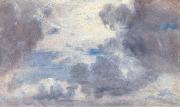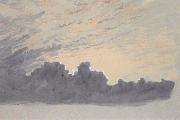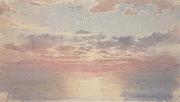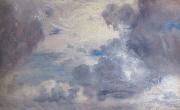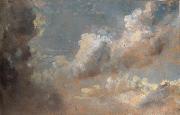
|
John Constable
|
|||
|
|
|||
| 1776-1837 British John Constable Locations 1837). English painter and draughtsman. His range and aspirations were less extensive than those of his contemporary J. M. W. Turner, but these two artists have traditionally been linked as the giants of early 19th-century British landscape painting and isolated from the many other artists practising landscape at a time when it was unprecedentedly popular. Constable has often been defined as the great naturalist and deliberately presented himself thus in his correspondence, although his stylistic variety indicates an instability in his perception of what constituted nature. He has also been characterized as having painted only the places he knew intimately, which other artists tended to pass by. While the exclusivity of Constable approach is indisputable, his concern with local scenery was not unique, being shared by the contemporary Norwich artists. By beginning to sketch in oil from nature seriously in 1808, he also conformed with the practice of artists such as Thomas Christopher Hofland (1777-1843), William Alfred Delamotte, Turner and, particularly, the pupils of John Linnell. Turner shared his commitment to establishing landscape as the equal of history painting, despite widespread disbelief in this notion. Nevertheless, although Constable was less singular than he might have liked people to believe, his single-mindedness in portraying so limited a range of sites was unique, and the brilliance of his oil sketching unprecedented, while none of his contemporaries was producing pictures resembling The Haywain (1821; London, N.G.) or the Leaping Horse (1825; London, RA). This very singularity was characteristic of British artists at a time when members of most occupations were stressing their individuality in the context of a rapidly developing capitalist economy | |||
|
|
|||
|
Cloud study new9/John Constable-228965.jpg Painting ID:: 32963 |
mk82 1822 | ||
|
|
|||
|
Conrad Martens
|
|||
|
|
|||
| England/Australia Painter , 1801-1878 Australian painter, lithographer and librarian of English birth. Son of a London merchant, he studied c. 1816 under Copley Fielding. His training was as a watercolourist and his most important works are watercolours, although he also produced paintings in oils. His early work displays the taste then current for the Picturesque. Francis Danby, David Cox and Turner were artists he admired. Martens left for India in 1832 or 1833 but at Montevideo joined Charles Darwin's expedition, replacing Augustus Earle as topographical draughtsman aboard the Beagle. The work strengthened his observation of detail and skill as a draughtsman. He left the expedition in October 1834 and, travelling via Tahiti and New Zealand, arrived in Sydney in April 1835. There he worked as a professional artist, in the 1840s and 1850s producing lithographic views of the Sydney area to augment his income. In 1863 he was appointed Parliamentary Librarian, which secured his finances. The skills he had acquired aboard the Beagle helped to gain him commissions to depict the estates around Sydney. However, his admiration for Turner, and with this the desire to elevate landscape as a subject, prompted him to subordinate line to mood in a Romantic treatment of the landscape. His thoughts were clearly stated in a lecture on landscape painting given in 1856 at the Australian Library, Sydney (see Smith, 1975). | |||
|
|
|||
|
Cloud study new9/Conrad Martens-662366.jpg Painting ID:: 33099 |
mk82 c.1850 | ||
|
|
|||
|
Conrad Martens
|
|||
|
|
|||
| England/Australia Painter , 1801-1878 Australian painter, lithographer and librarian of English birth. Son of a London merchant, he studied c. 1816 under Copley Fielding. His training was as a watercolourist and his most important works are watercolours, although he also produced paintings in oils. His early work displays the taste then current for the Picturesque. Francis Danby, David Cox and Turner were artists he admired. Martens left for India in 1832 or 1833 but at Montevideo joined Charles Darwin's expedition, replacing Augustus Earle as topographical draughtsman aboard the Beagle. The work strengthened his observation of detail and skill as a draughtsman. He left the expedition in October 1834 and, travelling via Tahiti and New Zealand, arrived in Sydney in April 1835. There he worked as a professional artist, in the 1840s and 1850s producing lithographic views of the Sydney area to augment his income. In 1863 he was appointed Parliamentary Librarian, which secured his finances. The skills he had acquired aboard the Beagle helped to gain him commissions to depict the estates around Sydney. However, his admiration for Turner, and with this the desire to elevate landscape as a subject, prompted him to subordinate line to mood in a Romantic treatment of the landscape. His thoughts were clearly stated in a lecture on landscape painting given in 1856 at the Australian Library, Sydney (see Smith, 1975). | |||
|
|
|||
|
Cloud study new9/Conrad Martens-449438.jpg Painting ID:: 33100 |
mk82 c.1850 | ||
|
|
|||
|
John Constable
|
|||
|
|
|||
| 1776-1837 British John Constable Locations 1837). English painter and draughtsman. His range and aspirations were less extensive than those of his contemporary J. M. W. Turner, but these two artists have traditionally been linked as the giants of early 19th-century British landscape painting and isolated from the many other artists practising landscape at a time when it was unprecedentedly popular. Constable has often been defined as the great naturalist and deliberately presented himself thus in his correspondence, although his stylistic variety indicates an instability in his perception of what constituted nature. He has also been characterized as having painted only the places he knew intimately, which other artists tended to pass by. While the exclusivity of Constable approach is indisputable, his concern with local scenery was not unique, being shared by the contemporary Norwich artists. By beginning to sketch in oil from nature seriously in 1808, he also conformed with the practice of artists such as Thomas Christopher Hofland (1777-1843), William Alfred Delamotte, Turner and, particularly, the pupils of John Linnell. Turner shared his commitment to establishing landscape as the equal of history painting, despite widespread disbelief in this notion. Nevertheless, although Constable was less singular than he might have liked people to believe, his single-mindedness in portraying so limited a range of sites was unique, and the brilliance of his oil sketching unprecedented, while none of his contemporaries was producing pictures resembling The Haywain (1821; London, N.G.) or the Leaping Horse (1825; London, RA). This very singularity was characteristic of British artists at a time when members of most occupations were stressing their individuality in the context of a rapidly developing capitalist economy | |||
|
|
|||
|
Cloud Study new9/John Constable-668435.jpg Painting ID:: 33146 |
mk82 182 oil on paper 29.2x48.2 | ||
|
|
|||
|
John Constable
|
|||
|
|
|||
| 1776-1837 British John Constable Locations 1837). English painter and draughtsman. His range and aspirations were less extensive than those of his contemporary J. M. W. Turner, but these two artists have traditionally been linked as the giants of early 19th-century British landscape painting and isolated from the many other artists practising landscape at a time when it was unprecedentedly popular. Constable has often been defined as the great naturalist and deliberately presented himself thus in his correspondence, although his stylistic variety indicates an instability in his perception of what constituted nature. He has also been characterized as having painted only the places he knew intimately, which other artists tended to pass by. While the exclusivity of Constable approach is indisputable, his concern with local scenery was not unique, being shared by the contemporary Norwich artists. By beginning to sketch in oil from nature seriously in 1808, he also conformed with the practice of artists such as Thomas Christopher Hofland (1777-1843), William Alfred Delamotte, Turner and, particularly, the pupils of John Linnell. Turner shared his commitment to establishing landscape as the equal of history painting, despite widespread disbelief in this notion. Nevertheless, although Constable was less singular than he might have liked people to believe, his single-mindedness in portraying so limited a range of sites was unique, and the brilliance of his oil sketching unprecedented, while none of his contemporaries was producing pictures resembling The Haywain (1821; London, N.G.) or the Leaping Horse (1825; London, RA). This very singularity was characteristic of British artists at a time when members of most occupations were stressing their individuality in the context of a rapidly developing capitalist economy | |||
|
|
|||
|
Cloud Study new9/John Constable-978475.jpg Painting ID:: 33147 |
mk82 1822 oil on paer 19.8x32 | ||
|
|
|||
|
Also Buy::. For Following Paintings / Artists / Products, Please Use Our Search Online: |






